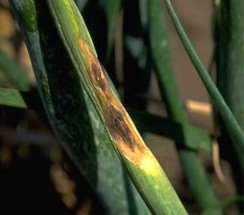-

Identify Nutrient Deficiency in Plants
Identify the Nutrient Deficiencies on your plants and Buy the Best products
-

Identify Pest & Intects on Plants
Identify Pest & Insects on your plants and Buy the Best products
-

Identify Diseases on Plants
Identify Diseases on your plants and Buy the Best products
Management of Purple Blocth in Onion Crop
- , द्वारा Agriplex India
- 4 मिनट पढ़ने का समय
Purple blotch is caused by the fungus Alternaria porri. It is a concern throughout the entire growing season. Infection occurs when fungal spores from nearby plants are blown by wind into onion fields where they infect wounded plants. Overwinters in crop residue on or near the soil surface.
Symptoms:
- Leaves - whitish minute dots on leaves with irregular chlorotic areas on the tip portion.
- Circular to oblong concentric black velvety rings appear in the chlorotic area.
- Leaves die from the tip downwards, break at the point of infection, and hang down.
- Bulbs – semi-watery rot, shrinkage of the fleshy bulb scales, and desiccation followed by these scales becoming dry and paperyLesions are elongate, small, sunken, and whitish with a purple center.
- Concentric light and dark zones later appear over part or all of the purple area. These blotches may enlarge (up to four inches long) and become covered with black fruiting bodies (spores).
- Storage symptoms appear as a dark yellow to wine-red spongy rot of the outer or inner scales of bulbs. The disease can reduce bulb yield and grade by 20% or more.


Cultural Control
Plant high-quality seeds and transplants free from the purple blotch pathogen.
Practice three-year or longer rotations to non-hosts such as small grains and corn. Reduce over-wintering and survival of the pathogens by eliminating culls,
onion debris, and volunteers. Avoid dense plantings of late-maturing varieties.
Apply adequate but not excessive nitrogen fertilizer before bulb initiation.
Undercut onion roots and harvest at full maturity when intact necks top over
naturally, ideally during dry weather. Thoroughly cure bulbs in the field and
before storage with ambient to warm (90 to 95°F) air. Maintain storage
temperatures near 32°F with a 70% or less relative humidity.
Chemical Control
Recommended Products Score 1ml per liter of water or Signum 1-2 ml per liter of water
Additional Tips:
- Monitor your crop regularly: Early detection of purple blotch allows for timely intervention and minimizes yield losses.
- Seek advice from local agricultural extension services: They can provide region-specific recommendations and guidance on managing onion diseases.
Remember: Implementing an integrated approach that combines preventive measures with judicious fungicide use is the most effective strategy for managing purple blotch and ensuring a healthy, high-yielding onion crop.
Conclusion
Purple blotch can be a significant threat to onion crops, but with proper management strategies, you can effectively control this disease and safeguard your yield. Remember, prevention is key. Implementing cultural practices like crop rotation, sanitation, and proper watering techniques alongside judicious use of fungicides when necessary, will create a comprehensive defense against purple blotch. By staying vigilant and taking proactive measures, you can ensure your onion crop thrives and delivers a bountiful harvest.
FAQ on Purple Blotch in Onion Crop
Q: What are the symptoms of purple blotch?
A: Symptoms first appear on older leaves as small, sunken, water-soaked lesions with light centers. These lesions enlarge, turn purple to brown, and often develop yellow rings, creating a "bull's-eye" pattern. Infected leaves may wilt and die. In severe cases, the bulb can become infected, leading to soft, water-soaked areas that turn dark reddish-purple and eventually brown/black.
Q: How does purple blotch spread?
A: The fungus survives on infected plant debris and spreads through windblown spores. Spores land on wet leaves and germinate, infecting the plant tissue.
Q: What are the best practices for preventing purple blotch?
A: The key to preventing purple blotch lies in cultural practices:
- Crop rotation: Rotate onions with non-susceptible crops for at least 3 years.
- Sanitation: Remove plant debris after harvest and during the growing season.
- Watering practices: Avoid overhead irrigation and opt for drip irrigation.
- Variety selection: Choose onion varieties resistant to purple blotch, if available.
Q: When should I use fungicides for purple blotch control?
A: Fungicides are most effective when used preventatively, especially during periods of high humidity and frequent rainfall. Always follow label instructions carefully regarding application rates, timing, and pre-harvest intervals.
Q: Are there any organic methods for controlling purple blotch?
A: While limited, some organic options exist, such as applying copper-based fungicides or using biocontrol agents like Bacillus subtilis. However, these methods may not be as effective as conventional fungicides. Consult your local agricultural extension service for guidance on organic control options in your region.
टैग
वेबदैनिकी डाक
-

, द्वारा Agriplex India Common Pests and Diseases in Indian Ginger Farming
Ginger, a pungent and versatile spice, is a vital part of Indian cuisine. However, cultivating this flavorful treasure can be a battle against pests and diseases....
-

, द्वारा Agriplex India Battling Major Pests in Soybean Crops
Soybean, a nutritional powerhouse, is under constant threat from a variety of pests. These unwelcome guests can significantly reduce yields and impact your farm's profitability....
-

, द्वारा Agriplex India Management of Major Insects of Okra/Bhendi
Management of Major Insects of Okra/Bhendi Okra or Lady Finger crops belong to the Malvaceae family. Okra is mostly grown for its green tender nutritive...
-

, द्वारा Agriplex India Biological Seed Treatment
Biological seed treatment consists of active ingredients that can include microbes like fungi and bacteria, as well as plant extracts and algae extracts. These microbes help the...
-

, द्वारा Agriplex India ಕೃಷಿಯಲ್ಲಿ ಬೀಜ ಸಂಸ್ಕರಣೆಯ ಪ್ರಯೋಜನಗಳು
ನಿಮ್ಮ ಬೀಜಗಳನ್ನು ಪ್ರಾರಂಭಿಸುವುದು: ಕೃಷಿಯಲ್ಲಿ ಬೀಜ ಸಂಸ್ಕರಣೆಯ ಪ್ರಯೋಜನಗಳು ಬೀಜಗಳನ್ನು ನೆಡುವುದು ಭರವಸೆಯ ಕ್ರಿಯೆ, ಭವಿಷ್ಯದ ಸುಗ್ಗಿಯ ಭರವಸೆ. ಕ್ರಿಮಿಕೀಟಗಳು, ರೋಗಗಳು ಮತ್ತು ಕಳಪೆ ಮೊಳಕೆಯೊಡೆಯುವಿಕೆಗಳಿಂದ ಬೀಜಗಳಿಗೆ ಹಾನಿಯಾಗಬಹುದು. ಬೀಜ ಸಂಸ್ಕರಣೆಯನ್ನು ಅಂಡರ್ಡಾಗ್ ಎಂದು...









